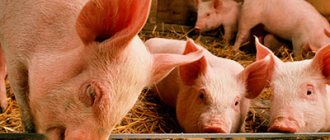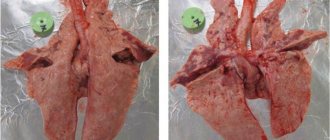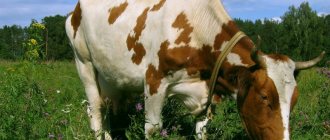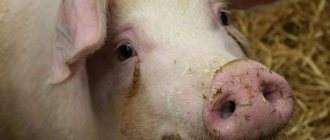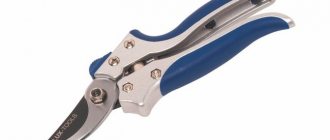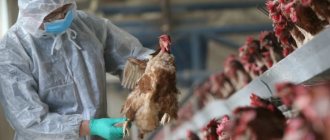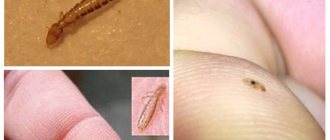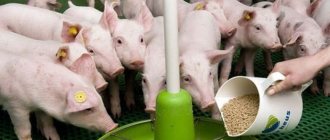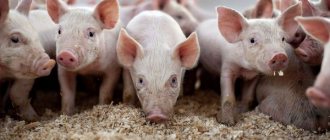Why are ectoparasites dangerous for pigs?
Ectoparasites - fleas and lice - often live on the body of pigs. The latter are the cause of the development of hematopinosis in animals. Hematopinosis (simply put, lice) is a disease caused by insects of the species Haematopinus suis that parasitize the body of pigs. This causative agent of hematopinosis is considered one of the largest representatives of the order of lice. Males can reach a length of 4.5 mm, females - up to 5 mm. A female pig louse is capable of laying 4-7 eggs per day (up to 100 eggs in a lifetime). An hour after hatching, the larva begins to suck the pig's blood.
On a note. The pig louse is the only type of lice that can drink the blood of not only pigs, but also humans. But people are not considered typical hosts for lice, and therefore the period of their parasitism on the human body is short-lived.
In the process of sucking blood, lice make punctures in the pig's body, after which they damage blood vessels and inject their saliva into the wound. The latter is considered toxic and prevents the clotting of pig blood.
Moving through the animal's body, lice irritate the nerve endings and provoke severe itching. The pig scratches its itchy spots on various surfaces. With strong scratching, the surface of the skin is often injured, sebaceous and sweat glands are destroyed. Pathogenic microorganisms penetrate into cracks in the skin, as a result of which the pig often develops pyoderma, furunculosis or eczema. Pigs suffering from severe itching suffer from decreased appetite, lose weight, and become more susceptible to various diseases. In addition, the pig louse often acts as a carrier of pathogens of invasive and infectious diseases (erysipelas, salmonellosis, swine fever, helminthiasis).
See also
Instructions for use of Tetramizole 10 for pigs, contraindications and analoguesRead
Treatment of pediculosis in pigs
Like many farm animals, pigs often harbor various ectoparasites on their bodies, causing a huge number of diseases that can cause significant problems and impair the productivity of pig-breeding land.
Ectoparasites are most often called insects that live on the surface of the skin or in the hair of animals and humans, which, as a rule, feed on the blood, sebum, and dead skin of their “hosts.”
The most famous pig ectoparasites are:
- Pork louse (Haematopinus suis) is the causative agent of porcine lice (haematopinosis);
- Representatives of the tick family:
- pork scabies mite (Sarcoptes scabiei suis) – the causative agent of the disease scabies (scabies);
- The pig eel (Demodex phylloides) is an ectoparasite that causes a disease called demodicosis.
Economic damage
Every year, due to diseases caused by the above parasites, significant material damage is caused to various pig-breeding enterprises around the world.
Damage occurs due to the following problems:
- high material and economic costs for treatment and prevention of head lice, scabies and demodicosis;
- significant reduction in pig productivity;
- ectoparasites are common carriers of swine fever, which often causes the death of the animal, causing even greater losses.
Pig louse
The development of head lice in pigs is a fairly common problem in many farms where pigs are raised. This is not due to the fact that the owners do not take measures to combat the parasites, but rather the problem is their survivability, excessively rapid reproduction, while treatment and measures to combat the parasite in themselves represent painstaking work.
The causative agent of pediculosis - brief description:
- is a light brown insect with an adult size of about 5-7 mm;
- carriers are both domestic and wild pigs;
- the favorite place of parasitism is in places with more delicate skin, which are the ears and areas around them, the limbs on the inside and the base of the animal’s neck;
- The pathogen of pediculosis spends its entire life cycle on an animal:
- after laying eggs and attaching them to the base of the animal’s hair, they mature in 1-2 weeks depending on the ambient temperature;
- a nymph emerges from the egg and feeds on the blood of the animal; within 5-12 days it becomes an adult, having gone through three molting processes;
- an adult lives through its entire cycle in about 1 month, feeding on the blood of a pig.
Clinical manifestations of pediculosis:
- with minor infestation of the animal, there is no clinical picture;
- anxiety in the animal;
- the formation of dark spots in the habitats and lice bites;
- the animal shows signs of inflammation, redness, burning, itching at the bite sites, the pig itches against surrounding objects;
- in animals under stress, the appetite decreases, the amount of food consumed is significantly reduced, which leads to a decrease in live weight;
- if the number of lice is massive, then the animal (usually young animals) may develop anemia due to the large amount of blood consumed by the parasites;
- Since the causative agent of pediculosis can carry swine fever, there is a high probability of this disease occurring.
Signs of swine fever:
- red spots on the animal’s body 1-2 cm in diameter;
- progressing, the spot enters the stage of a bubble with light yellow contents;
- after 2-3 days the bubble bursts, and in their place black areas with a scab form;
- signs of secondary dermatitis.
Prevention and treatment of pediculosis
Preventive measures against pediculosis are of paramount importance, as they protect animals from the disease, reduce material costs for treating animals and production losses.
Preventive actions:
- mandatory constant inspection of pigs, especially those that develop symptoms similar to head lice;
- avoiding overcrowding of animals;
- rapid isolation and treatment of lice-infested pigs;
- constant maintenance of enclosures where animals live clean;
- preventing excess humidity in enclosures;
- Regular washing with water and cleaning the skin of healthy animals.
Treatment of lice in pigs:
- external use of various drugs and solutions that destroy parasites (washing with a 4-5% aqueous solution of soap, 1% chlorophos);
- An effective remedy is a 10% emulsion of tar and green soap (10 g of soap is dissolved in 1 liter of hot water, after cooling to 45-50 ° C, 100 g of tar are added), animals are treated with this emulsion once every 5-7 days;
- double treatment with disinfectant (naphthalene and coal dust in equal proportions) with an interval of 24 hours, this product quickly kills insects;
- use of the injection drug "Ivomec", which is used at the rate of 1 ml per 50 kg of animal weight, administered subcutaneously. The disadvantage of the drug is its price and the fact that the animal is slaughtered no earlier than 30 days after its use.
Signs of defeat
You can determine that a pig is suffering from a lice infestation by the following signs:
- Severe itching. Small wounds and long, thin red scratches can be seen on the skin of a sick animal.
- Availability of eggs. They track well on the skin of white pigs. As a rule, lice lay eggs on tender areas of the body: on the stomach, behind the ears.
- Adult lice can be seen with the naked eye - they are black or brown insects whose body length, on average, reaches 3-4 mm.
In addition to these signs, the farmer may note paleness of the animals’ skin or, conversely, areas covered with reddish spots. A large number of lice can cause anemia in an animal, especially in piglets. The animal may become lethargic and suffer from lack of appetite.
Pig lice and pig fleas. How to remove it and how to treat it?
Ectoparasites affect all mammals. Traces of the lesion can be seen in many adult boars and pigs. Piglets often have lice. They not only bring discomfort, but are also carriers of infectious diseases. Their saliva causes allergies, so the herd must be treated.
Pig fleas and lice: features of parasitism, symptoms
Mammals lack intense fur, the so-called. bristle. This is a short hair whose functions are the same as those of all other animals. It is a habitat for parasites - fleas and lice.
Difference between species
Fleas are insects that parasitize only animals. Lice come in different types and infect humans. Parasites that harm livestock are not harmful to you.
The differences are minor:
- size: fleas are larger than lice;
- stages of development: lice do not have a pupa;
- mode of movement: fleas jump, lice only crawl;
- features of parasitism: lice live only on the skin, fleas live anywhere.
Both parasites attach to the skin of a mammal and feed on blood and lymph. One individual does not cause significant harm, but the abundance of parasites threatens disease. They also carry deadly infections such as distemper.
Ectoparasites are dangerous for young animals and recently weaned piglets. Anemia (anemia) leads to deterioration of health, and if the disease is not noticed in time, it can lead to death.
Symptoms of the lesion
These include:
- Severe itching. Long red scratches and small wounds are visible on the skin.
- Availability of eggs. Well visible on White breed pigs. Attached to delicate areas: behind the ears, on the stomach.
- Lice accumulate near the ear, fleas live throughout the body, but prefer areas with thin skin (closer to blood vessels).
- Adults can be seen with the naked eye: brown or black mobile insects, up to 3-4 mm in length.
In addition to these signs, you can notice pale skin and redness. Large numbers of fleas or lice, especially in piglets, cause anemia. The animal quickly loses condition, becomes lethargic, and eats poorly. An allergic reaction to saliva or waste products is possible. The most effective diagnosis is a thorough examination of the individual several times a day.
Treatment of lice in pigs and removal of fleas
There are many ways to remove lice from pigs. Effectively use the following drugs: Vermectin, Doramectin, Amitraz, Phosmet. Therapy must be carried out in all animals at the same time. If the damage is minor, then the patients are temporarily isolated. Fleas in pigs are removed with the same drugs. Brushing and bathing adults are ineffective.
Convenient to use spray. Ivermectin can be injected under the skin. It is medications that show the best results: in mild cases, only 1 procedure is needed. If the herd is treated, Ivermectin is repeated again after 18-21 days.
Solutions of chlorophos 1% or 0.1-0.25% solution of benzene hexachloride are added to the methods of treating lice in pigs. It is recommended to treat all surfaces, especially bedding, with disinfectants. There may be live fleas and lice eggs in it.
Lice in piglets: harmless treatment for young animals
All methods for removing lice from piglets involve minimal use of aggressive chemicals. It is better to avoid folk remedies with diluted kerosene, etc. There are several ways to get rid of lice in piglets:
- Combing. Use a fine-toothed comb over the entire body, picking out lice. This is also a good way to remove fleas from piglets. Disadvantages of the procedure: long, ineffective when there are a large number of ectoparasites, needs to be repeated several times.
- Bathing with special shampoos. One of the most effective methods, you only need 1-2 procedures. A spray is also applied to the skin, which destroys adult individuals. After a while, repeat treatment to destroy young lice and fleas. Advantages: the products act against all parasites at the same time, they are fast. Disadvantages: Some farmers consider them to be chemicals that harm the meat.
Therefore, folk remedies are added to the means to remove lice from a pig: smearing with sunflower oil, bathing in a bath with laundry soap and ash. The effectiveness of the methods is lower than that of drugs; the procedures will have to be repeated more times.
To prevent parasites from appearing:
- Observe the maintenance regime, walk the livestock.
- Keep individuals from other farms in quarantine and inspect their skin. Keep the pig barn clean.
Pig fleas and lice cause discomfort to the animal and threaten the health of the livestock, because... carry infections. Therefore, it is better to get rid of ectoparasites. Pharmacy remedies remain the most effective, but many abandon them in favor of folk remedies.
Lice in pigs: a serious illness or a minor problem? Link to main publication
Rules for treating parasitic disease
The first thing a farmer needs to do is separate infected pigs from other pigs. To eliminate the symptoms of hematopinosis, the following drugs are used:
- Doramectin;
- Phosmet;
- Amitraz;
- Vermectin.
When preparing a disinfectant solution from these insecticides, you must follow safety rules and follow the instructions.
In addition to directly treating the skin of pigs, you need to disinfect the walls and floor of the barn with the resulting solution. Hexachloran or similar drugs can also be used for disinfection. It is recommended to burn the bedding on which the animal sleeps. The pigs should not be in the barn during the treatment.
Healthy young piglets should also be treated with one of these solutions. This procedure is carried out for the purpose of prevention.
3 weeks after the initial treatment with an antiparasitic drug, repeated treatment must be carried out. Previously infected individuals can be combined with healthy ones 3 weeks after repeated disinfection.
See also
How to feed a sow at home after farrowing to produce more milkRead
Traditional methods of treatment
Some medications to combat hematopinosis are prohibited for use in the treatment of young animals or pregnant pigs. Farmers often eliminate lice from tiny piglets or sows using traditional methods. For example, at an early stage of diagnosing hematopinosis, parasites are eliminated by combing out. Vegetable oil and kerosene can be used to treat animal bodies. These ingredients are mixed in equal proportions and distributed over the skin of the sick individual.
Green soap and tar are considered good remedies against parasites. To prepare the medicine, you need to mix 10 grams of soap with 100 grams of tar and dissolve the ingredients in 1 liter of warm water. The disadvantage of traditional methods of therapy is that such remedies destroy adult lice, but do not affect their eggs.
Therefore, after the initial treatment, you should definitely repeat the procedure for a more thorough destruction of harmful insects.
Lice in pigs, treatment with folk remedies
Ectoparasites include insects that feed on blood and live on the body or hair of an animal. The most famous pig parasites are:
- Pig louse that causes head lice. It has a light brown color and a size of 5-7 mm.
- The pig eel infects pigs with demodicosis.
- The scabies mite gives the animal scabies.
Signs of infection
The development of head lice in pigs occurs quite quickly, so it is very important to notice the parasites at the initial stage. The longer lice live on the body of an animal, the more strongly they infect the body of their “host”.
If a small number of parasites live on the animal’s body, then this can only be observed visually. By examining the skin and ears, you can detect egg laying. When there are a lot of parasites, it will begin to cause inconvenience to the pig.
The pig will become restless and its appetite will decrease, which will affect weight loss. At the bite sites, the animal will be bothered by an itchy burning sensation, which will force it to rub against something to stop the itching.
Such actions will lead to skin injuries.
Itching bothers animals
Pathogens and methods of infection
Sarcoptes parvula mites parasitize pigs of any age; The ears and ear canals of animals are primarily affected .
Sarcoptes scabiei var suis primarily affects piglets, infecting the skin all over the body (total form of scabies).
Otherwise, the pathogenic insects are very similar: both species have a slightly flattened oval body up to 0.5 millimeters long.
The photo taken under a microscope shows the subcutaneous mite Sarcoptes scabiei
Adults live up to 8 weeks. Once on the skin of a pig, females gnaw passages under its surface and lay eggs in them (up to 8 eggs per clutch), from which larvae hatch after 3-5 days. The offspring go through 3 growth stages of 3-5 days each with intermediate molts.
Over the course of her entire life, a female tick can lay up to 60 eggs . The larvae live in the upper layer of the epidermis, feeding on its cells, and when they mature, they crawl out to the surface of the skin.
Individuals of different sexes mate, after which the females colonize new areas of the pig’s body and gnaw through the next passages for their offspring.
Pigs get mites from each other. At air temperatures above +10 degrees and high humidity, parasites are able to live outside the host’s body for about two weeks. In a pigsty, they settle on wooden partitions, walls and floors of pens.
It has been established that when a healthy herd is released into a poorly cleaned room, after a few days 100% of the herd is affected by ticks.
In addition,
itching travels long distances , clinging to equipment, clothing of farm staff, and the fur of rats, mice, cats and dogs.
Rodents and small predators do not suffer from scabies, but serve as carriers of parasites. Sometimes people also catch ticks from pigs .
Insects are not capable of reproducing in human skin, but cause unpleasant symptoms of the disease, as well as allergic reactions.
Characteristic symptoms and forms of the disease
The vital activity of mites causes severe, obsessive itching, and the skin damage caused by parasites serves as entry holes for pathogens of secondary infections.
Through skin damage caused by ticks, pathogens of secondary infections easily enter the animal’s body.
The presence of sarcoptic mange in a pig can be determined by the following signs :
- the animal constantly tries to itch, shakes its ears, sometimes tries to bite the affected areas on the skin;
- small (up to 0.4 mm in diameter) red dots appear on the surface of the body, often located in pairs (as in the photo below), since the tick usually gnaws separate holes in the skin for entry and exit;
- In the places of bites, when scratched, wounds form, then blisters that “get wet” and fester, and subsequently become covered with scabs. If the infection is severe, significant areas of the pig's body may be covered with a solid, hard crust of a dark brown color;
- the stubble of affected pigs becomes sparse and falls out;
- the top layer of skin in the affected areas thickens (sometimes 4-5 times) due to damage to the connective tissue. Rough, strong “folds” are formed, between which there are deep depressions in which liquid almost always secretes and accumulates;
- the pig becomes nervous, eats poorly, and loses weight.
Small red dots at the entry and exit points of ticks turn into festering wounds and blisters when scratched.
An accurate diagnosis of parasitic infestation is made based on a skin test . To do this, scrape the epidermis (it is better to take it from the auricle or area next to the ear). If the test does not give results, it is repeated after 3 weeks.
Adult pigs suffering from the ear form of sarcoptic mange survive the disease relatively easily, sometimes even asymptomatically. Scabies is much more dangerous for piglets , who can receive the pathogen from infected sows before reaching the age of one month.
In weanlings 2.5-3 months old, the so-called “generalized” invasion (the most aggressive form of the disease) is sometimes observed, in which most of the body surface is affected. Babies lose a lot of weight and die from exhaustion and general intoxication.
Fortunately, this happens relatively rarely.
Weakened, sickly piglets are at greatest risk of parasitic infestations.
At risk are weakened piglets with low immunity, prone to colds or suffering from vitamin deficiency.
Treatment of scabies in pigs
To rid pigs of sarcoptic mange pathogens, use:
| Method | Advantages and disadvantages |
| Injections of antiparasitic drugs (for example, Doramectin or Ivermectin) | Medicines are sold in veterinary pharmacies in the form of ready-made solutions, which are administered subcutaneously at the rate of 0.3 mg per kilogram of live weight. The method is considered very effective, but has its drawbacks. Firstly, when the medicine is administered, living insects die, but their eggs remain unharmed. To get rid of the larvae that are about to hatch, the injection must be repeated after two weeks. During this period, the pig should not be given any other medications. Secondly, this method is not suitable for large farms, since it is quite difficult to administer medicine to each of several hundred animals, having previously calculated the individual dose. Thirdly, such injections are not recommended for very young piglets (this may be unsafe) |
| Feeding food additives (premixes - Ivermectin or Ivomex) | The drugs, which are available in powder form, are mixed into the feed over the course of a week, taking into account individual dosages. The method is suitable for treating young animals weighing no more than 40 kg, living on private farmsteads (in large farms, animals eat from common feeders and it is almost impossible to ensure that each piglet receives the required dose of medicine) |
| Spraying the entire livestock with liquid medicinal compounds (Phosmet, Amitraz, Sebacil, Ivermectin, etc.) | Such drugs are used in the form of solutions prepared in accordance with the standards specified in the instructions. Each animal is sprayed, trying to wet the entire surface of the skin. Before the procedure, pigs are washed with soapy water with the addition of creolin or medicinal creosote to remove dirt and most of the scabs and crusts. Treatment is carried out directly in the pen, from which all bedding, feeders and drinkers are first removed |
Folk antiparasitic remedies
, effective folk remedies are also used to combat scabies :
- sour cream with gunpowder in a ratio of 3:1. The mixture must be infused for at least 3 hours, and then applied in a thin layer to the affected skin;
- garlic oil extract . Mix 500 ml of mustard oil and 100 g of chopped garlic cloves, bring to a boil, simmer over low heat for 20 minutes, cool and strain, squeezing out the grounds. The oil is applied to areas infested with mites;
- ointment from the rhizome of white hellebore and shoots of wild rosemary . The raw materials (50 g of each type) are thoroughly crushed (it is better to grind them into powder) and mixed with 100 g of melted lard. The ointment is very effective, but unsafe, since hellebore contains toxic substances (alkaloids). If the animal tends to bite off areas affected by sarcoptic mange, it is better not to use the product;
- soap mixture . Laundry soap is grated, mixed with a small amount of water and melted over low heat. Add a crushed clove of garlic and a chopped onion. Pour the mixture into small molds and cool. The resulting “soap” is rubbed onto the skin of the pigs (not only sore spots, but the whole body);
- tobacco ash . Tobacco leaves are burned (you can take cigarette ashes), and the ash is rubbed into the places of bites and scratches. Then sulfur ointment is applied to the animal's skin.
Folk remedies are often used to treat young piglets, whose health can be harmed by more aggressive pharmaceutical drugs.
Why do piglets itch and what should be done?
Scabies in pigs (sarcoptic mange) is one of the most common parasitic diseases, which is manifested by unbearable severe itching. An itchy pig experiences severe discomfort and anxiety.
Prevention measures
To prevent pigs from becoming infected with head lice, preventive measures should be taken:
- Control humidity in the barn. Lice multiply well in damp environments, so the pigs' home should be dry.
- Animals are examined for parasites several times a month, even if there are no visual signs of their presence.
- The premises where pigs are kept should be cleaned regularly.
- It is recommended to wash animals with clean water once a month.
- In winter, when pigs are not allowed to graze or go outside, the barn in which they are kept should be well lit.
How are they detected?
Without knowing what the bites of linen lice look like, blood-sucking insects are quite difficult to identify, and their appearance often goes unnoticed. Itching and signs of skin damage are attributed to tight, tight underwear, allergies, and local irritation. Pests have only one feeding tool - the mouthparts, equipped with special outgrowths that, when viewed under a microscope, resemble stilettos. At the moment of the bite, a special secretion is injected under the skin, into the wound, to prevent blood clotting.
Specialists from the Sanepidemstation.com service warn: Secretory substances secreted by blood-sucking parasites can cause the development of severe allergic reactions. When infected, such a wound quickly becomes inflamed and heals poorly. When a colony of insects acquires alarming proportions, the number of bites increases, and bluish spots form on the surface of the skin.
